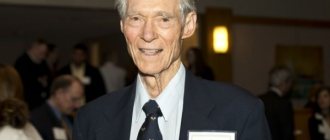.
The success of any organization depends on many factors. One of them is good management. Leadership in an organization determines the vector of the company’s development and encourages employees to work to achieve results. But the idea of the functions of a leader in a particular company is not fully defined. Even the person claiming this title often has little understanding of what is required of him.
Characteristics of a leader
A leader is a person who has a set of certain qualities that allow him to influence team members to achieve the goals of the organization.
The main qualities of a leader are:
- responsibility - the ability to complete undertaken obligations, to be responsible for their implementation;
- communication skills - the ability to find a common language with the company’s management and its employees;
- flexibility - the ability to quickly adapt to changing conditions in the organization;
- broad outlook and desire to constantly gain new knowledge;
- friendliness - the ability to build relationships with all team members, to be friendly;
- diligence - the desire to work under any circumstances;
- determination and perseverance - the ability to set goals and achieve them; Patience is the ability to wait for results.
Leaders in organizations become leaders in different ways:
- due to the presence of leadership abilities that a person initially has; through the active development of individual leadership qualities;
- due to a fortunate combination of circumstances that allowed him to prove himself and move forward.
In most cases, employees themselves choose from their circle a person suitable for the role of leader.
Subsequently, this person may be appointed to a leadership position.
Understanding the concepts
In this article we will not dwell on the general concept of leadership, but will move directly to the topic of informal leadership. If you are interested in learning about theories related to this topic, about the skills necessary to develop leadership in yourself, we recommend taking our free course “Leadership: Lessons from an Effective Leader.”
Of course, if there is an informal leader, one should also talk about the presence of a formal one. quite easy to distinguish them :
- a formal leader is a person who has power over colleagues and influence on them due to his higher status, position, position;
- an informal leader is a person who has power over colleagues and influence on them for a variety of reasons not related to position or status.
Accordingly, if we abstract from the company in the yard and transfer the concept of leadership to any organization, or rather to the organization’s team, then we can note that the formal leader is a manager, director, in other words, a representative of the highest level of the corporate hierarchy. It happens that this person can also be an informal leader, but an informal leader is a leader who spontaneously acquires greater influence. But is it really spontaneous?
In fact, in each case of the “emergence” of an informal leader, there is a clear reason. These reasons include:
Coincidence
Or, in another way, situationality, i.e. the presence of some factor of a random nature. The slogan for such situations is usually “in the right place at the right time.” For example, if a manager delegates a task to one of his employees, and force majeure happens to him and he drops out of work, and you are right there playing the role of a little superhero, then you have the potential to qualify for the role of an informal leader. In this case, circumstances played in your favor.
Expertise
Are you familiar with the following dialogue?
— Somehow our numbers don’t add up again...
- Let's show Maria, she'll definitely figure it out!
- Let's! Good idea.
As you can guess, Maria is known as an expert, a person you can turn to and get help with in any situation with numbers. Calling upon the services of a person who can navigate out of a stormy situation is another characteristic of an informal leader. If, in addition to this, Maria has leadership qualities, then she can definitely be called such.
The strategy of the formal leader is wrong
It is quite obvious that if the formal leader has some shortcomings, then the team chooses a person who embodies compensation for these shortcomings. After all, think about it, talking in secret about the boss is a classic genre of corporate conversations, and it is in such conversations that a variety of portraits of the director are compiled - professional, psychological, moral, stylistic, etc. From here all the mistakes, gaps in his work, character flaws are revealed. So why not find another person to fill in the missing puzzles for the perfect picture?
Within this reason, several options are possible:
- the manager lacks some skills (for example, analytical thinking, emotional intelligence, etc.);
- ignoring a number of functions by the formal leader (for example, he does not come to planning meetings and is always replaced, or he does not go into details of reporting, etc.);
- the leader’s use of one management style over a long period of time (you can read more about this in the “Leadership Styles” section).
Pay attention to the last of these points. It is he who says that it is periodically necessary to change behavior and use different management methods, because a team is a moving environment that adapts to the conditions of the dynamic development of the outside world.
The departure of the informal leader
It is quite logical that if a formal leader leaves a team, a new one should take his place. By the way, in many cases they differ significantly from each other, which proves the need to “update, reboot the system.”
The arrival and departure of personnel to a company is an integral process of its life. New people are often different from previous employees, and the previous informal leader may not meet their needs. In principle, an informal leader is the same employee of the organization, so he changes periodically, this is an objective process [N. Volosaeva, 2015].
And the fifth reason leading to a change in the informal leader is a change in manager. But let's talk about this in the context of the relationship between the two leaders. Before we move on to this section, have you ever been in a situation where you witnessed both types of leaders in a team? If yes, share your experience in the comments: how did they manage to share the reins of power and was this tandem overall successful? And we continue to share what informal leaders are and how to deal with them.
Characteristics of leadership
Leadership is a complex process of influencing people to achieve organizational goals. There are several important signs of leadership:
- it is designed to influence employees to encourage them to be active;
- designed to make other employees want to work;
- focused on achieving a common goal that unites all team members;
- forms followers who can become independent leaders in the future;
- strives for self-organization within the team, streamlining all processes; sensitively captures the needs of those involved in the zone of influence.
Leadership typology
There are different models of leadership in organizations. The division is carried out according to several criteria.
Depending on the influence mechanisms used, the following are distinguished:
- formal leadership - leaders become leaders by appointment, this concept is identical with official leadership, real power is in his hands, which he exercises within the framework of his powers, the impact on the team is carried out through disciplinary measures;
- informal leadership - influence on people is exerted not through administrative resources, but due to the personal characteristics of the leader.
By style of behavior there are:
- authoritarian - all management in the organization is concentrated in the hands of one person, who expects unquestioning obedience and execution of his orders; the initiative of other team members is not encouraged;
- democratic - involves the distribution of duties and responsibilities between all members of the team, communication ties within the team are developed, key decisions are made jointly;
- liberal - the leader delegates most of the powers to his followers, often withdrawing from solving assigned tasks, entrusting them to members of the team.
Depending on the personality characteristics of the leader:
- charismatic - the leader has abilities that he uses to organize the work of the team;
- situational, in which the leader can easily adapt to constant changes in the organization, can engage in reform, and is not afraid of innovative ideas;
- attributive, which involves building detailed cause-and-effect relationships, their analysis, an analytical mindset, and a tendency to painstaking and monotonous work.
Depending on the focus, leadership is divided into:
- aimed at people, in which the well-being of employees and their job satisfaction are put above all else, a lot of attention is paid to the psychological climate in the team;
- aimed at the interests of the organization, when all forces and means are aimed at achieving the set goals.
Business leaders to follow by example
7. Reshma Saujani – Saujani is the founder of Girls Who Code. Which promotes learning technologies (especially coding) for girls. She is an American business leader, lawyer and politician. Her company, Girls Who Code, has hosted camps in 42 states, serving more than 10,000 girls. 8. Jack Ma – Ma was the first mainland Chinese entrepreneur to appear on the cover of Forbes magazine. He is also the founder of Alibaba Group, a group of internet companies. Before entering the Hangzhou Teachers Institute, Ma was denied admission to university three times. After graduating, he applied for 30 jobs and was rejected for all of them. He first learned about the Internet during a short trip to the United States. When he returned home, he created a small website about China and Chinese products. This will be his first step towards creating a company that will hold the record for the largest IPO in history. 9. Jan Koum - Koum was born in Kiev, Ukraine. Moved to the United States when he was 16 years old. He soon discovered his passion for programming and enrolled at San Jose State University. After a short stint at SJSU and a stint as a security tester at Yahoo. Godfather launched WhatsApp. WhatsApp has quickly become one of the fastest downloaded apps on the App Store. And one of the most used applications internationally. Koum sold WhatsApp to Facebook in 2014 for approximately $19.3 billion. 10. Bill Gates - Gates founded Microsoft, the world's largest PC software company. Every year he consistently ranks at the top of the list of the world's richest people. Over the years, Gates has gradually moved away from Microsoft and toward philanthropic work. His foundation, the Bill and Melinda Gates Foundation, works to provide clean water and sanitation (among other things) to third world countries. Like Warren Buffett, Gates has also pledged to give away most of his wealth to charity.
The role of leadership in an organization
The role of leadership is difficult to overestimate; without it, an organization is doomed to stagnation at best, and to cease to exist at worst. Leadership coordinates all processes occurring within and directs them in the most favorable direction for everyone. It often has a more effective impact on employees than a clearly organized vertical of power in the company.
The leader fully participates in the functioning of the organization, setting goals, formulating tasks, and finding ways to solve them.
Sometimes, from the leadership side, the true needs of the organization are seen from a different perspective, which allows them to be satisfied faster.
Unites managers and subordinates, encouraging them to concentrate efforts to solve common problems. It is possible that it will be difficult for both sides; leadership influence should smooth out all the rough edges, find compromises, help avoid conflicts or find the right ways out of conflict situations.
Actively participates in personnel selection. The success and advancement of the organization depends on this, so an informal assessment of a potential employee benefits all parties in the work process.
Leadership is intrinsically linked to corporate culture. It forms and develops it, creates and maintains corporate values in the team.
Leadership roles are not always clearly regulated; they can be expressed in spontaneously organized measures of support, positive influence, inspiration for new achievements, and de-escalation of the work environment. The mood of employees is one of the main forces that allows them to cope with difficulties and achieve their goals.
Types of informal leaders and strategies for dealing with them
As we have already found out, the emergence of an informal leader is a fairly natural phenomenon for any organization, but what is his power based on? It turns out that in every team there is a need for one or another component of interpersonal relationships, therefore the figure of an informal leader can be characterized by several types, depending on what the given team lacks. Let's look at these types in more detail.
Emotional type
Imagine that in your organization there is a strict leader who controls all phenomena from a formalist position, does not allow familiarity, and strictly regulates all key processes. Naturally, any person at some point will have a desire to be a little relaxed, to share his personal experiences, to see in the eyes of his boss not only numbers, instructions and tasks, but also an offer to drink coffee together. And at such a moment, the emotional informal leader saves the situation.
This person helps team members express what they have accumulated during their work, personifies emotional support, can listen and encourage. In addition, one of his strengths is the ability to be charged with some idea, present it in an interesting and bright light and infect others with it. The downside is that it can go out just as quickly. Therefore, here a formal leader should come to the rescue, understanding whether the proposed idea is worthy and whether it is worth investing resources in it.
The danger of such a leader is that if he is in a bad mood, he can overwhelm the team with negativity in the same way as if he is in a good mood.
What to do? Supervisor control is mandatory here.
If you see that such an informal leader is on a wave of positive emotions, delegate tasks to him, load him with tasks in moderation, so that he energizes other team members while working. If the informal leader is mired in negative emotions, help him get out of them: pay attention to the positive aspects, benefits and benefits even in problematic aspects. And try to match his emotional mood - it is unlikely that such a person will listen to a monotonous neutral leader.
The next type of informal leadership is directly related to one of the above reasons for its appearance.
Expert type
Of course, if a company is marked by the presence of a professional to the core, a person who lives for work and knows almost all internal processes from the inside, this person willy-nilly will become an informal leader only because he will enjoy authority. Often such an informal leader is considered an unemotional cracker, but this is not always the case and depends on each specific case. Obviously, many employees will contact him and ask for help, and this entails a small risk.
This risk lies in the fact that this type of informal leader may begin to manipulate processes in the company, because has unique resources - knowledge.
What to do? The formal leader must draw up a fair bonus system and prevent violation of the professional boundaries of certain employees. In addition, it is important to emphasize the knowledge and professionalism of the expert at every opportunity and respect his qualifications.
If circumstances have already developed such that the business expert is opposed to the formal leader, then the latter should do his best to prevent this, in particular:
- improve your qualifications - otherwise you won’t get recognition and respect;
- show your expertise in related fields, if any.
Those. We hit the enemy with his own weapon. However, if these methods do not work, then we advise you to create a situation in which the expert turns out to be not so competent at all, i.e. his authority will be shaken. This will generate doubts in the minds of team members and will sharply hit the self-esteem of the arrogant business leader.
But for the next type of informal leader, the concept of “boundaries” and their violation is relevant.
“Shirt-guy” (or “shirt-girl”)
The most charming, the most attractive, the life of the party, a person radiating positive energy - do you recognize any of your colleagues in this description? If not, think again, because these guys are quite common.
As a rule, these are people who have friendly relations with almost all colleagues, and also enjoy special favor from their superiors. By the way, many may begin to dislike such a person for this, especially when:
- he focuses the listeners’ attention on the fact that he has informal meetings with his boss, they are close, maybe friendly (“So, yesterday we sat in a restaurant with Pal Palych and he told me...”)
- he strictly controls the process of rapprochement between his colleagues and his superiors, fearing that they will not go far, because afraid of losing his “special position.”
What to do? Be that as it may, the manager should keep at a distance any employee who encroaches on the title of “shirt guy”, because violation of professional boundaries naturally ends in conflict. Immediately outline professional barriers and make it clear to the employee that violating them and moving into personal space is unacceptable. If necessary, start a serious conversation with an honest expression that familiarity at work is fundamentally prohibited for you, as a manager [E. Morley, G. Gardner Homes, 2015].
The next type of informal leader is the exact opposite of the “shirt guy”.
Leader of the Opposition
Well, of course, where would we be without critics! Don’t think that our attitude towards criticism is neutral and even positive if it is constructive, but this type of informal leader strives to find flaws and shortcomings in any manifestation of the will and determination of the boss.
Obviously, not all employees always agree with the decisions of their superiors, but almost no one has the courage to express this disagreement. And here a superhero comes to the rescue, becoming a thorn in the side of the formal leader.
Introduce a system of new productivity indicators in the company? For what? The old system works fine anyway. Terminate contracts with old customers and sign new, more promising ones? But the risks are too high! Are we collecting 700 rubles for a gift to the chief accountant? Yes, something is too much... And so on any issue. But what is more unpleasant is that often such informal leaders, having secured the support of the majority, use it to promote personal interests, i.e. the role of the informal leader in this case is quite significant.
You're lucky if the leader of the opposition gets by with just words and indignation. In a worse perspective, he may become a rebel, begin to put forward his own conditions, and commit real actions leading to the destabilization of corporate peace.
In general, as you understand, formal leaders have nightmares about such oppositionists.
What to do? Rebels and opposition leaders are people who have a colossal reserve of energy, because, think about it, if they have enough strength to constantly accuse, search for injustice, try to turn the team against the formal leader, then the latter needs to take advantage of it. It is necessary to direct his energy in a creative direction, load him with work, give instructions to level out the injustices that he finds, entrust him with socially significant tasks.
There is also one important nuance: tough non-stop critics always pursue some goal, in other words, they want something. Therefore, the task of the formal leader is to find out what exactly the rebel wants and what personal motives he is pursuing. By finding the answer to this question, the problem can go away by finding a solution. But how do you understand what the leader of the opposition wants?
It’s all very simple: if a formal leader periodically communicates for more than 10 minutes with key subordinates (who usually become such rebels), then he himself will be aware of all the unmet needs of his team. However, it is clear that this is not always possible. Especially in large companies, where the number of such subordinates is quite large. In this case, when the leader of the opposition appears, the eminence grise can take up this issue.
We’ll find out who it is and what its functions are below. With this type of informal leader, things are much calmer.
Eminence grise
A certain “right hand”, an assistant to the main boss, who managed to gain his trust, gaining access to rumors and conversations behind the proscenium curtain. The gray cardinal is an intelligent, tactically thinking person, flexible and diplomatic by nature. Precisely due to the presence of the latter characteristics, people turn to him for help, share their thoughts, and the boss takes advantage of his humble servant, often underestimating his cunning.
The gray cardinal is an informal leader with highly developed skills of effective communications. If you want to have real skill in communicating with people, show flexibility and charisma, perhaps planning to become an eminence grise, then we advise you to take our online program “Best Communication Techniques”. In this program, you will learn all the techniques described above, learning 72 methods of effectively interacting with people around you using interesting examples and exercises.
However, behind all the mentioned advantages of such a leader is the inability to take responsibility, because such a person does not strive to make final decisions. He will rather guide, advise, orient...
Psychologist Veronika Stepanova expresses her opinion quite boldly about such individuals. You can listen to it in this video :
Do you agree with Veronica or have a different point of view? Share your answers in the comments. We will share the strategy of correct behavior with the gray eminence.
What to do? You need to be able to negotiate with the gray cardinal, to set his behavior in the direction that will bring triple benefit:
- for a formal leader;
- for himself;
- for the team as a whole.
In addition, remember that the best means of manipulating an eminence grise is the amount of power. If you want to encourage him, give him more authority; if you want to punish him, take it away. But remember that fear is an integral characteristic of gray cardinals, therefore, whenever rewarding such an informal leader with responsibility, do not forget to back him up.
We hope that you understand the types of informal leaders. Let's now look at historical examples of personalities-puppeteers who exercised leadership not in the first person.
Leadership, power, management
Leadership, power and management are close, but not identical concepts. Power is associated with leadership and is always directed from top to bottom. Leadership can come from below and span all layers of the organization. It can merge with power, possess its features, partially use its methods, but it tries never to use external force.
Management is a management system that implements the tasks set by the management of the organization.
Managers act according to established plans and schedules. Manager's tasks: fulfill instructions, achieve certain indicators. They act out of necessity, not out of their own desires. Management uses effective leverage over employees and exercises control over all processes.
Leadership management in an organization
Managing an organization's leadership includes several important elements:
- Actions aimed at identifying leaders in the organization. It is necessary to find those who already have a sufficient set of knowledge and skills or are potentially ready to develop them in themselves.
- Establishing interaction with employees in order to find out their needs, wishes, and provide motivation.
- Creating conditions for deepening and developing leadership skills.
- Provide opportunities to receive additional education and deepen knowledge.










